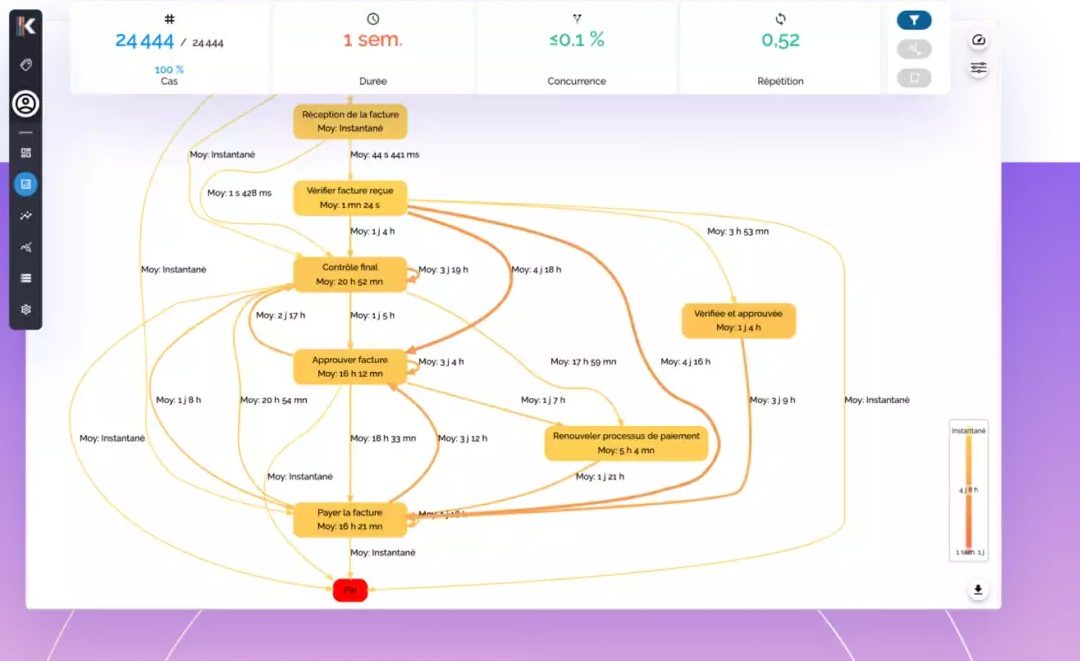The increasing digitalization of businesses, integrated processes, and increased usage of Big Data is driving demand for new methods to extract value from data and recognize patterns that might have been missed.
To improve their decision-making process, organizations today need to improve their understanding of their customer needs, discover hidden patterns and opportunities, and spot any inconsistencies in data. This will help them run targeted marketing campaigns, automate the process of decision-making, and justify future change.
These are just some primary usages of business process mining.
What is business process mining? What are the benefits of applying it? And what are some of the challenges you might need to deal with?
This article will cover all these questions.
What is Business Process Mining?
Data mining is the procedure of finding patterns in big data sets and extracting meaningful insights from them. It applies data science to discover, validate and improve workflows.
By combining data mining and process analytics, organizations can mine data from the information available in their systems, to understand the performance of their processes.
This process is valuable in revealing bottlenecks and other areas of improvement.
Business process mining is based on a data-driven approach to process optimization, allowing decision-makers to be more objective in their resource-allocation decisions for existing processes.
This process can be automated so that it is implemented every time a new piece of information is available. This is an essential part of analytics, which is the practice of finding insights from information and using them to make decisions.
How Does Process Mining Work?
Process mining utilizes data from various IT systems, such as Customer Relationship Management (CRM) tools, Enterprise Resource Planning (ERP), and Enterprise Business Process Management (EBMP), to create a “Process Model”, or process graph.
The goal is to examine the end-to-end process and highlight any variations and patterns in the process. This is done through specialized algorithms that can provide insights into the root causes of deviations.
The procedure looks like something this:
The Benefits of Process Mining
Let’s explore some of the benefits of process mining:
#1. Reduction of operational costs
Process mining can help your organization reduce costs by detecting and quantifying the bottlenecks and inefficiencies in its operational models. This will allow leaders to make better decisions about the allocation of resources.
#2. Develop a better understanding of the organization’s as-is processes
Process mining can help you visualize your organization’s “as-is processes” and help users understand how processes progress by utilizing event logs and real-time data.
#3. Decision-making based on data
The tools used by process mining increase the availability of data, enabling decision-making to be based on a data-driven approach. With the absence of process mining, it is more challenging for organizations to have process data visibility.
#4. Improvement of customer experience and satisfaction
There are several ways that process mining can improve your customer experience and overall satisfaction. It includes reducing lead times, reducing your organization’s reaction time, spotting and resolving bottlenecks, and achieving better harmony between interrelated processes.
#5. Compliance betterment
Applying process mining will lead to better compliance by processing and analyzing data from audits efficiently, and identifying in real-time non-compliant processes.
#6. Process automation
Process mining can help your organization in identifying the tasks in your processes that will benefit the most from automation. By using event data logs, it can derive how cases are handled and how decisions are made.
#7. Continual improvement
There are no restrictions on how often you may want to apply process mining to your processes. It is a continuous and continual improvement practice that will benefit your organization every time you apply it.
Limitations of Process Mining
A few worth mentioning would include:
– The quality of data
To be able to benefit from process mining, locating, cleaning, and merging of data is required.
This is a serious challenge in some cases where data is distributed over a wide number of data sources. Incomplete data, different labeling, and other issues could be a challenge that you need to initially deal with. It will affect the outcome of your process mining efforts tremendously.
– The drift of concept
In many case scenarios, processes change while they are being mined and analyzed. This could result in a drift of concept and will affect the final outcome.
– The right-tool
Some traditional process mining tools may be limited in the types of data sources they can connect to, which can limit the value they can provide.
Conclusion
source: iGrafx Process Explorer 360 screenshot
Data is the new oil and process mining is the process where you get the best benefit out of your data.
It’s the new way to power your company, but it also comes with obstacles that need to be dealt with thoroughly.
Process mining is one way to get insight from your data and examine it to discover patterns and make decisions. It can be challenging, but it’s a terrific way to acquire insight into what’s occurring in your business.
The last note I want to share with you is that process mining is not a one-time thing. It’s an approach and a way of doing business analytics.
In their published PDF, “Process Mining Manifesto”, by the Institute of Electrical and Electronics Engineers (IEEE), 2011, they emphasize that process mining should be a Continuous process. I quote from the publication:
“Given the dynamic nature of processes, it is not advisable to see process mining as a one-time activity. The goal should not be to create a fixed model, but to breathe life into process models so that users and analysts are encouraged to look at them on a daily basis”.
If you want to know more about process mining and implement state-of-the-art software that will help you reap the benefits of applying it, click below to learn more.

